Dry process porcelain is the cheapest type of porcelain to make. It is also
the poorest quality for electrical use due to the inherent porous nature. Some
dry process porcelain is high quality and difficult to distinguish from wet
process porcelain even at the firing rest or if a chip exposes the porcelain.
Dry process porcelain was made from clay with a low water content. The clay was
flaked to a consistency similar to saw dust. An adequate portion was the put in
a two-part mold and pressed under very high pressure to form the desired shape.
Usually mold lines are present if the glaze is not too thick. Sometimes extra
care was provided by wiping off the mold lines with a wet sponge. Another basic
difference is the profile of the insulator was not trimmed in as with wet
process insulators. The profile with side wire groove was formed in the mold and
you can usually see a mold line across the wire groove. The mold line is not
always an indicator of dry process porcelain. Fred Locke and Pittsburg often
used two-part molds to make wet process insulators.
Dry process porcelain
afforded a way to make difficult shapes because it used two-part molds. Most
knobs, cleats, spools, etc. (call standard porcelain) were made by the dry
process. The voltages were low and adequate electrical protection was afforded.
However, Pittsburg cataloged a spiral groove insulator identical to CD 147 made
of wet process porcelain. However, none have ever been found. Macomb made dry
process insulators in four-part molds. The crown was one part, two parts for the
profile, and a fourth part to form the base. A characteristic mold line around
the base is indicative of Macob manufacture.
Most companies either made dry
process or wet process insulators. Thomas wanted to give their customers a
choice. They made a low voltage line of dry process insulators as an alternative
to their higher quality and more expensive wet process insulators. This was
obviously very successful because there are many styles of low voltage dry
process Thomas insulators still in service and showing up all over the country.
Thomas even went after the foreign market for low voltage insulators. I doubt
they were very successful because foreign customers were use to high quality wet
process insulators, which did not have mold lines, surface imperfections,
obvious porous porcelain, and an overall cheap appearance. This did not
discourage Thomas from offering no less than seven styles. Since none have been
reported found outside the U. S., we have no way of knowing how successful they
were. Jerry Turner and his family dug in the Thomas dump many years ago and found a lot of broken foreign style insulators. Note
that all of the foreign style insulators discussed here have a very small
foreign style pinhole, so they cannot be confused with insulators made for the
U. S. market with the basic 1-inch pinhole.
Not all porcelain Gingerbread Men
are made alike. Thomas made that style, too. Besides finding broken specimens at
the Thomas dump, we recently uncovered further evidence in the form of five
styles offered in the 1925 American Jobbers Supply Co. catalog. At first glance,
it appeared that the five styles were offered were not made by Thomas. The
catalog states, "Standard Electric Porcelain manufactured for us by
Illinois Electric Porcelain Co., Macomb, Illinois:'
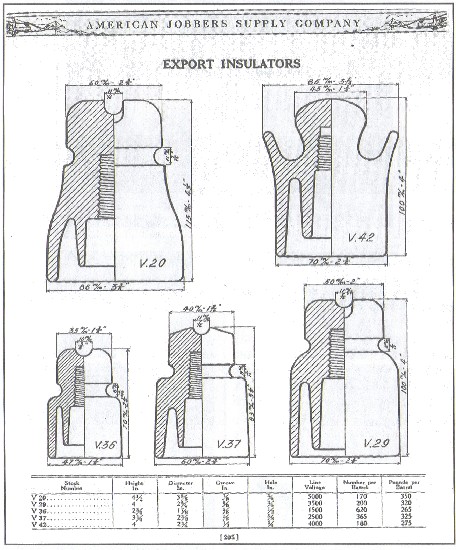
Page from the 1925 American Jobbers Supply Co. catalog.
The U. S. style pin-types in
the catalog are obviously Illinois manufacture, but the single page of foreign
styles use a different catalog numbering system with a "V" before the style number. This
probably indicates a different manufacturer. The two foreign styles found at the
Thomas dump match exactly to the dimensions shown on this page, which indicates
strongly the catalog styles were made by Thomas. Furthermore, Jack Tod believed
Illinois phased out dry process insulators in the 1920's after converting to wet
process manufacture in 1915. It is more likely that they phased out dry process
before 1920 preferring to concentrate on wet process. Thomas may have tried to
switch their dry process manufacturing to foreign styles when the U. S. market
for dry process pin-types fell off dramatically by 1920. It does appear that
most U. S. dry process insulators were made prior to 1920 with Thomas being the
primary supplier.
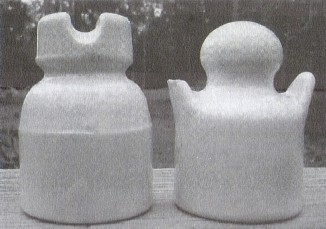
Thomas V29 and V42 styles found at the Thomas dump.
V29 and V42 were the most common style found at the Thomas dump. Whole
undamaged specimens of V42 have been seen at insulator shows, which probably
originated from the dump. The two smaller styles, V36 and V37 have not been
reported. Robin Harrison reported V20, which he always thought was foreign made
even though it appeared to be made of dry process porcelain.
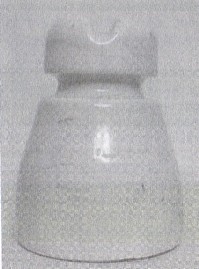
Robin Harrison's Thomas V20.
Dennis Stewart and his father found an odd twist-lock style, too, at the
dump. Essentially all foreign porcelain insulators are wet process. If you find
a foreign style that was made of dry process porcelain, chances are Thomas made
it.
Thomas also cataloged. two standard porcelain styles (No. 42 and No. 43),
which are twist-lock styles. The No. 38 style is actually the U.S. style, U-143
and U143A. Thomas cataloged this style (#1032) in their normal catalog without
reference to it being one of the standard porcelain styles. No. 44 has a foreign
appearance but none have been reported.
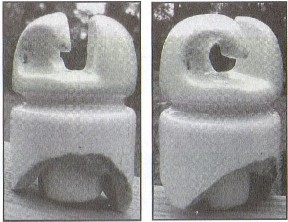
Intricate twist-lock style made by Thomas
Numbering of standard porcelain styles approached 100 and pin-type insulators
were the exception. Dennis Stewart found a white glazed No. 43 at the Thomas
dump. A near perfect No. 43 with a dark brown glaze was shown around at the 2002
Springfield show last November by Alan Hohnhorst. A Standard No. 42 has not been
reported.
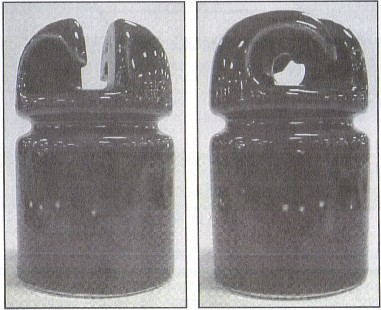
Brown glazed Thomas foreign style twist-lock insulator
from the collection of
Alan Hohnhorst.
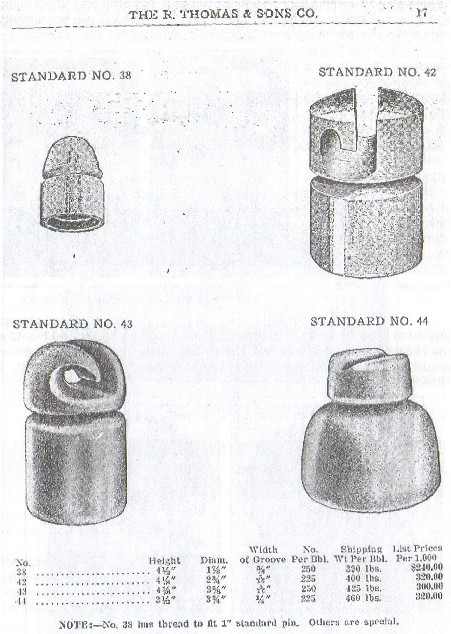
Another odd thing to note is the 1901 Western Electric catalog of Standard
Porcelain shows No. 38 to be identical to the Thomas No. 42. And the Western
Electric No. 42 and No. 43 split nail-knobs. This doesn't sound very "standard". Other companies also made the Thomas Standard No. 42.
at the factory was dated April 20, 1908, and called for a white glaze. The
twist-lock top was more similar to the Thomas No. 43.
All this about U. S. made
foreign dry process insulators is a very interesting and a little researched
part of our hobby. I would like to hear from anyone with additional catalog
information or photographs of specimens.
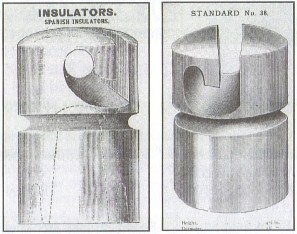
Spanish insulator shown in the 1894 Walker & Kepler catalog. (Left)
From
the 1901 Western Electric catalog. (Right)


































































